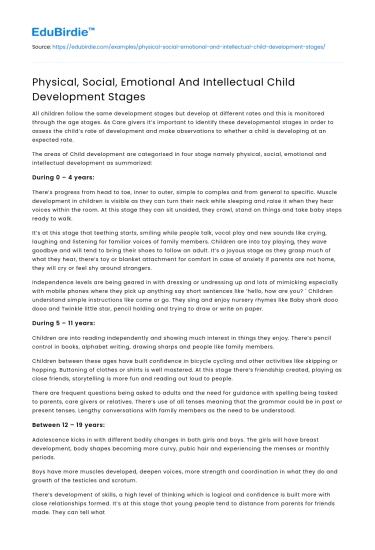All children follow the same development stages but develop at different rates and this is monitored through the age stages. As Care givers it’s important to identify these developmental stages in order to assess the child’s rate of development and make observations to whether a child is developing at an expected rate.
The areas of Child development are categorised in four stage namely physical, social, emotional and intellectual development as summarized:
Save your time!
We can take care of your essay
- Proper editing and formatting
- Free revision, title page, and bibliography
- Flexible prices and money-back guarantee
During 0 – 4 years:
There’s progress from head to toe, inner to outer, simple to complex and from general to specific. Muscle development in children is visible as they can turn their neck while sleeping and raise it when they hear voices within the room. At this stage they can sit unaided, they crawl, stand on things and take baby steps ready to walk.
It’s at this stage that teething starts, smiling while people talk, vocal play and new sounds like crying, laughing and listening for familiar voices of family members. Children are into toy playing, they wave goodbye and will tend to bring their shoes to follow an adult. It’s a joyous stage as they grasp much of what they hear, there’s toy or blanket attachment for comfort in case of anxiety if parents are not home, they will cry or feel shy around strangers.
Independence levels are being geared in with dressing or undressing up and lots of mimicking especially with mobile phones where they pick up anything say short sentences like ’hello, how are you? ´ Children understand simple instructions like come or go. They sing and enjoy nursery rhymes like Baby shark dooo dooo and Twinkle little star, pencil holding and trying to draw or write on paper.
During 5 – 11 years:
Children are into reading independently and showing much interest in things they enjoy. There’s pencil control in books, alphabet writing, drawing sharps and people like family members.
Children between these ages have built confidence in bicycle cycling and other activities like skipping or hopping. Buttoning of clothes or shirts is well mastered. At this stage there’s friendship created, playing as close friends, storytelling is more fun and reading out loud to people.
There are frequent questions being asked to adults and the need for guidance with spelling being tasked to parents, care givers or relatives. There’s use of all tenses meaning that the grammar could be in past or present tenses. Lengthy conversations with family members as the need to be understood.
Between 12 – 19 years:
Adolescence kicks in with different bodily changes in both girls and boys. The girls will have breast development, body shapes becoming more curvy, pubic hair and experiencing the menses or monthly periods.
Boys have more muscles developed, deepen voices, more strength and coordination in what they do and growth of the testicles and scrotum.
There’s development of skills, a high level of thinking which is logical and confidence is built more with close relationships formed. It’s at this stage that young people tend to distance from parents for friends made. They can tell what acceptable or unacceptable behaviour Young people is are more responsible with the words they speak, actions and are will require help in case of disagreements. Young people are more cooperative around children of the same age bracket and are willing to help out with light activities around the house.






 Stuck on your essay?
Stuck on your essay?

